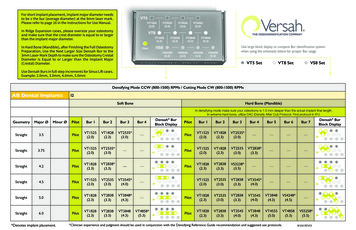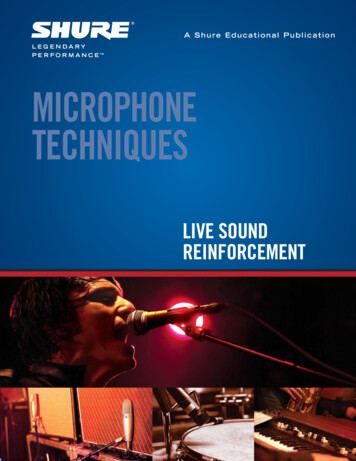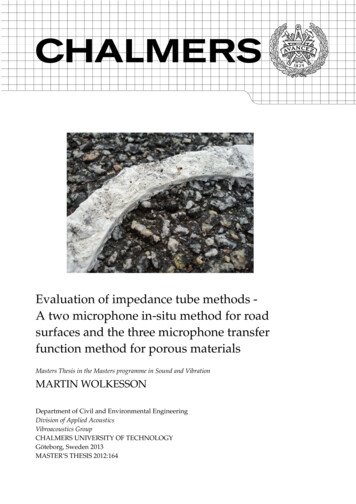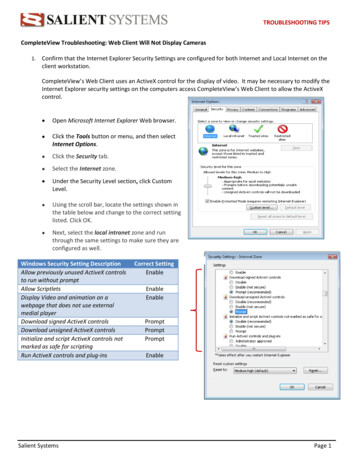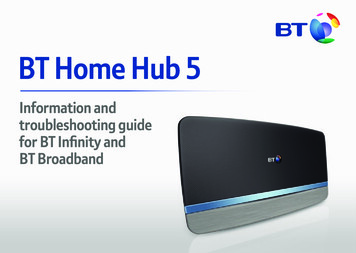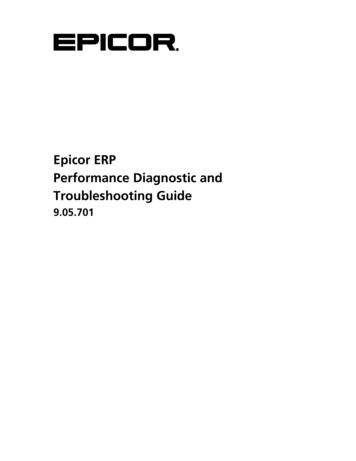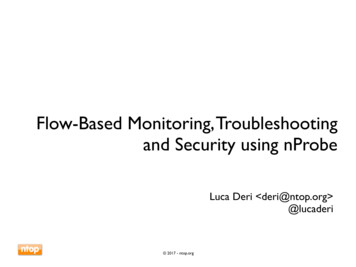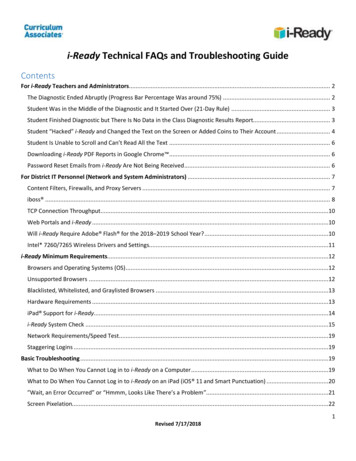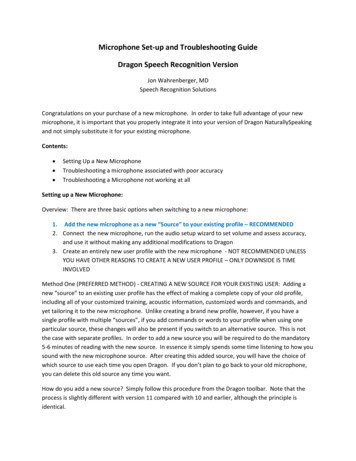
Transcription
Microphone Set-up and Troubleshooting GuideDragon Speech Recognition VersionJon Wahrenberger, MDSpeech Recognition SolutionsCongratulations on your purchase of a new microphone. In order to take full advantage of your newmicrophone, it is important that you properly integrate it into your version of Dragon NaturallySpeakingand not simply substitute it for your existing microphone.Contents: Setting Up a New MicrophoneTroubleshooting a microphone associated with poor accuracyTroubleshooting a Microphone not working at allSetting up a New Microphone:Overview: There are three basic options when switching to a new microphone:1. Add the new microphone as a new “Source” to your existing profile – RECOMMENDED2. Connect the new microphone, run the audio setup wizard to set volume and assess accuracy,and use it without making any additional modifications to Dragon3. Create an entirely new user profile with the new microphone - NOT RECOMMENDED UNLESSYOU HAVE OTHER REASONS TO CREATE A NEW USER PROFILE – ONLY DOWNSIDE IS TIMEINVOLVEDMethod One (PREFERRED METHOD) - CREATING A NEW SOURCE FOR YOUR EXISTING USER: Adding anew “source” to an existing user profile has the effect of making a complete copy of your old profile,including all of your customized training, acoustic information, customized words and commands, andyet tailoring it to the new microphone. Unlike creating a brand new profile, however, if you have asingle profile with multiple “sources”, if you add commands or words to your profile when using oneparticular source, these changes will also be present if you switch to an alternative source. This is notthe case with separate profiles. In order to add a new source you will be required to do the mandatory5-6 minutes of reading with the new source. In essence it simply spends some time listening to how yousound with the new microphone source. After creating this added source, you will have the choice ofwhich source to use each time you open Dragon. If you don’t plan to go back to your old microphone,you can delete this old source any time you want.How do you add a new source? Simply follow this procedure from the Dragon toolbar. Note that theprocess is slightly different with version 11 compared with 10 and earlier, although the principle isidentical.
Dragon 11 Versions, Including Medical PracticeEdition1. Select Profile Add Audio Source toCurrent .Dragon 10 and earlier1. Select Dragon Open User 2. On the far right of the Open User dialog,click on “Source” and then “New”3. Select the new source from those listedand following the usual steps to completethe training for the new source.4. If you want to delete your old source(doing so will prevent it from showing upfor potential selection each time you openDragon), simply go to Dragon Open Userand select the old profile. Then click on“Source” and then Delete.2. Follow all subsequent instructions3. When done, if you want to delete your oldsource, go to Profile Manage UserProfiles and on the screen that comes upselect your old profile and then click on“delete” on the right.Method Two – SIMPLE SUBSTITUTION OF ONE MIC FOR ANOTHER: The simplest way to switch to a newmicrophone is simply to plug it in, run the audio set-up wizard to set the microphone volume andconfirm basic accuracy, and to use it. How do you run the audio set-up wizard? With Dragon 11, including the Medical Practice Edition, on the Dragon toolbar click on Audioand then select “check microphone”. If you have more than one sound source available you willbe presented with a screen in which you choose your current source. If Dragon detects only onesource, it will bring you directly to the microphone volume and audio check steps. With Dragon 10 and earlier, on the Dragon toolbar, go to Tools Accuracy Center Check MyAudio Settings and follow the instructions. The advantage of this is simplicity. When moving
from one wired microphone to another (especially when moving to a more accuratemicrophone) this is often adequate. If you are changing the type of microphone (i.e. movingfrom a wired to a wireless microphone or visa versa, switching from a simple microphone [3.5mm plugs] to a USB microphone, or switching to or from a Bluetooth microphone) this simplemethod is not advisable.Method Three (RARELY NECESSARY BUT NEVER BAD TO DO AND GIVES YOU A FULLY “FRESH” START):This is the least preferred method, it that it requires you create an entirely new profile from scratch,using the new microphone. We recommend this only if you have an existing profile which is eitherextremely new (you haven’t invested much into it) or extremely old (AND suspected to be somewhatcorrupted). Here are instructions for creating a new user profile from scratch.1.Export any words and commands from your old profile so you can import them into your newprofile once created.a. Export your old words from the Dragon toolbar by going to Words Export. Save yourwords to a location that you will remember.b. Export you commands by opening the Command Browser (Tools Command Browser).Under the Mode menu, select “Manage”. Click the box next to the command categoryyou want to export and then click on Export on the left menu2. For Dragon 11, from the Profile menu select “New User profile ” . The “New User Profile”screen (shown below) will appear and you should select new and follow all subsequentinstructions, being sure to select the new microphone or audio device (if a USB microphone) asthe new audio source.
3. For Dragon 10 or earlier, from the Dragon select Manage User. Either way, you will see a screenequivalent to the screen in the next step which lists any existing user profiles. You should select“New” and follow all subsequent instructions, being sure to select the new microphone or audiodevice (if a USB microphone) as the new audio source.Dealing with a Microphone which is working but with Poor AccuracyWhether a new microphone or your old one, getting less than ideal speech recognition results may ormay not be a consequence of microphone issues. Keep in mind that accuracy is dependent upon manyfactors and the most important of these is your dictation style. In this situation we recommend asequential approach, as follows:1.First, rule out obvious audio issues by listening to a recording of your speech. There are manyways to do this but simplest method is simply to dictate some text and then use Dragon’splayback functionality to hear your speech. This is done by expanding the Dragon toolbar toshow the “Extras Bar”, selecting the text you dictated, and then clicking on the play button.
Listen to the recording to be sure it sounds clear and that there are no word cut-outs, static orother interfering sounds. If so, you likely have a mechanical problem related to the microphoneor sound card. If the sound seems to be clean, then proceed to the next step.2.Run the audio set-up wizard. This takes just a couple of minutes and resets your microphonegain and also provides a crude check of your system integrity by means of providing a speech tonoise ratio. The audio set-up wizard can be access either by saying “check audio” or manuallyby going to Tools Accuracy Center Check My Audio Settings. As long as you get a speech tonoise ration between 15 and 25, your system is probably OK. Don’t get hung up on the exactnumber as this is a very crude test and the exact number does not necessarily correlate withyour actual accuracy.3. If you are using a laptop computer, it likely has an on-board microphone. If you are using amicrophone plugged into the sound/microphone jacks, it is possible that Dragon is using the onboard microphone and not the one you have plugged in. You should manually disable the onboard microphone and this will likely resolve your issue. Alternatively, use a USB interface foryour microphone (external USB sound adapter). These are inexpensive devices that substitutefor your on-board sound card.4. If the steps above showed that the microphone seems to be working but your accuracy remainslow, we suggest that you devote extra attention to your dictation style. Keys to optimaldictation are the following: Enunciate clearlySpeak in a smooth manner, neither overly slowly or excessively rapidly. Speak in eithersentences or phrases. Recognition is worst when speaking one word at a time.Maintain a relatively consistent pitch and tone when dictating5. Consider creating a new user profile. Sometimes an old profile becomes contaminated andsimply doesn’t give great results. Creating a new profile takes less than 10 minutes, doesnothing to remove your old profile, and will let you know very quickly if a contaminated profilewas your issue.
6. Consider switching to a USB microphone or use your current microphone with an external USBadapter. This may be particularly helpful if you are using a laptop computer. The external USBadapter substitutes for your internal sound card and offers the possibility of removing internalelectrical interference which may be negatively impacting your accuracy.7. Consider upgrading to a higher quality microphone. Be aware that the microphone that camewith your version of Dragon cost Nuance about 10 or less. There are many better microphonesthat offer better accuracy and rejection of external noise.Microphone isn’t working at allThis is a rare situation, but one which leads to great frustration. Keep in mind that Dragon will only usea microphone that is being recognized by the operating system. So after visually inspecting themicrophone to rule out obvious mechanical issues, you should take steps to assure that the operatingsystem is recognizing the microphone.Here is our basic protocol:1.Visually inspect the microphone and cord (and external sound device if being used) to be surethere is no evidence of damage to the wire.2. Be sure your microphone doesn’t have a mute switch. If so, be sure that the muting function isnot activated3. If possible, use the microphone with another application, either on your current computer oranother to assess its integrity in another environment. For instance, try your microphone withSkype or another audio application which uses a microphone.4. Confirm that your operating system is sensing the microphone:a. Windows 7 & Vista: Go to your control panel Hardware and Sound Sound, and clickon the recording tab. You should see your microphone. When talking, you should seedeflections in the green sound magnitude scale. While this is only a crude test, failureto show any evidence of sound is certainly an indicator that something is wrong.Alternatively you can open up the “sound recorder” (all programs accessories soundrecorder). Unfortunately the sound recorder in Windows Vista and 7 is very pared downand does not allow you to listen to the recorded sound but, rather, forces you to saveyour recording as a wav file which you must open separately to listen to. Theappearance of the sound recorder is shown belowb. Windows XP: Confirming a microphone is more difficult in XP than in 7. Often, thesimplest method is to try a sample sound recording. This is done as follows:i. Click on Start All Programs Accessories Entertainment Sound Recorderii. On the sound recorder Edit menu, select Audio Properties
iii. Under the Sound Recording section, be sure your sound device is correctlychosen (select your on-board sound card if using a microphone plugged into themic and sound jacks; if using a USB microphone or device, select the namecorresponding to the device – many USB sound adapters show up as AK5370 inwindows XP)iv. Make a sample recording by clicking on the record button. If audio is beingrecorded you will see deviations in the green signal line in the center of therecording.v. Hit the rewind button to bring you back to the beginning of the recordingvi. Hit the play button and listen to the recording5. If you are using a laptop and have a microphone plugged into the sound-out and microphonejacks, it should be disabling the on-board microphone, but there are many examples of this notbeing the case. It is possible that Dragon is taking the sound signal from the on-boardmicrophone and not the microphone you have plugged in. In this case you should attemptmanually disable the on-board microphone. This method varies from machine to machine andmay not be possible. As a last resort (but nonetheless an excellent solution), get yourself anexternal USB sound adapter and do away with the problem. Dragon will be directed to take itsound signal from the USB device into which you microphone is plugged and the on-boardmicrophone will no longer harass you!6. If you are plugging your microphone into the sound and microphone jacks on your computer,confirm that you have these properly selected. In general the sound jack is marked in green andthe microphone jack in pink or red. If you have more than one set of jacks (front and rear), tryplugging the microphone into the other set. If you know your microphone is otherwise workingbut not with your PC, consider the route of using an external USB sound adapter.
Dragon 11 Versions, Including Medical Practice Edition Dragon 10 and earlier 1. Select Profile Add Audio Source to urrent . 2. Follow all subsequent instructions 3. When done, if you want to delete your old source, go to Profile Manage User Profiles and on the screen that comes up
